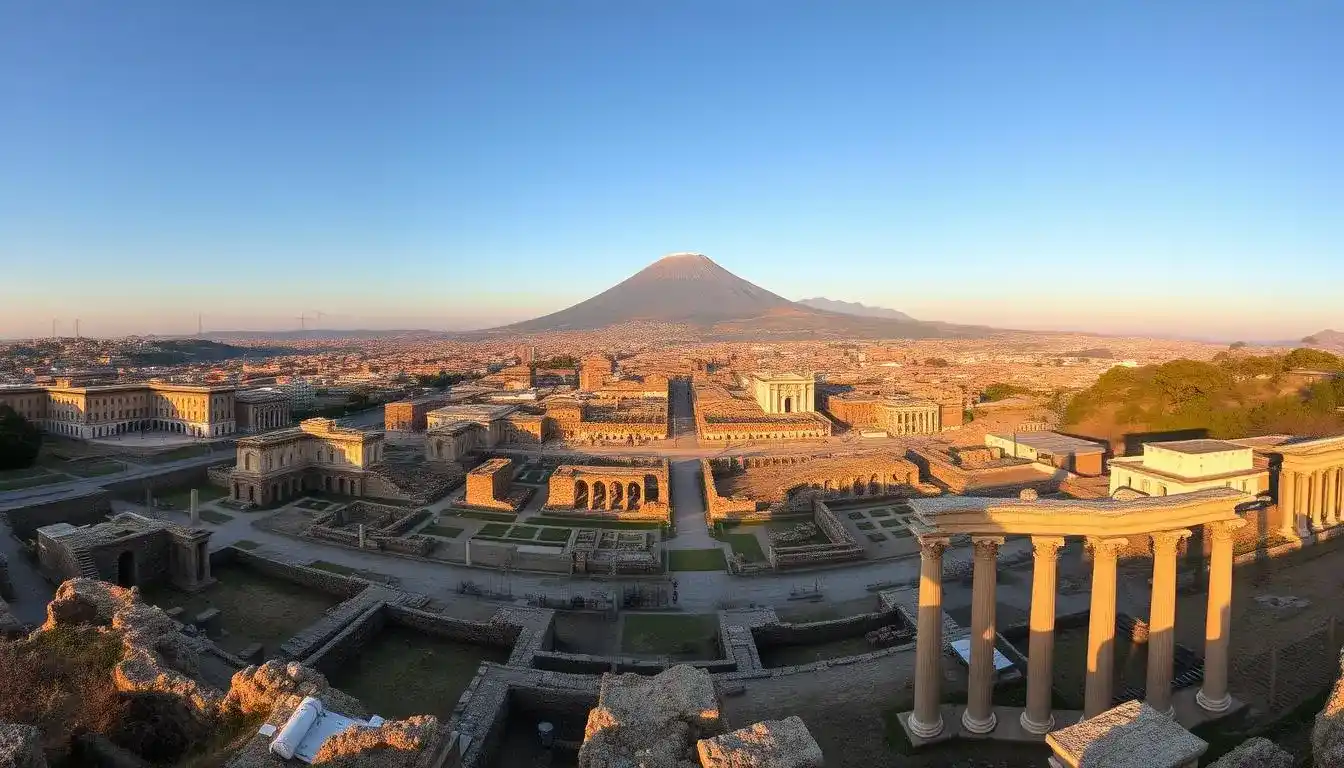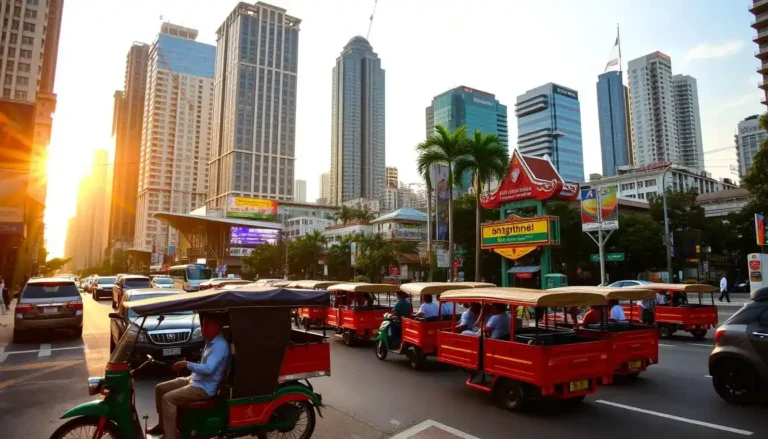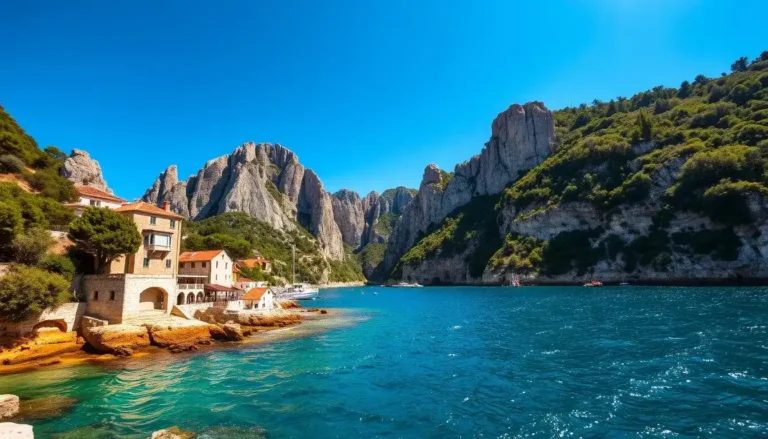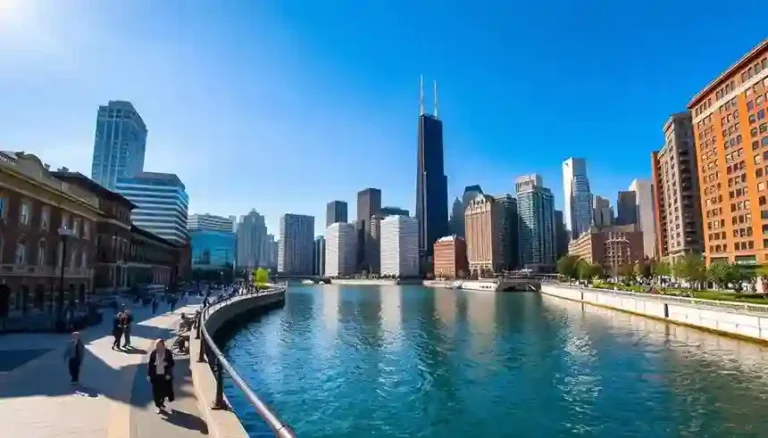The Ultimate Guide to Visiting Pompeii
Discover the ancient city of Pompeii, frozen in time by the devastating volcanic eruption of Mount Vesuvius. This fascinating historical site offers a unique glimpse into life in ancient Rome, making it a must-visit destination for history buffs and travelers alike.
Planning a trip to Pompeii can be overwhelming, but with our comprehensive Pompeii travel guide, you’ll be well-equipped to make the most of your visit. From must-see attractions to practical tips on how to navigate the ruins, we’ve got you covered.
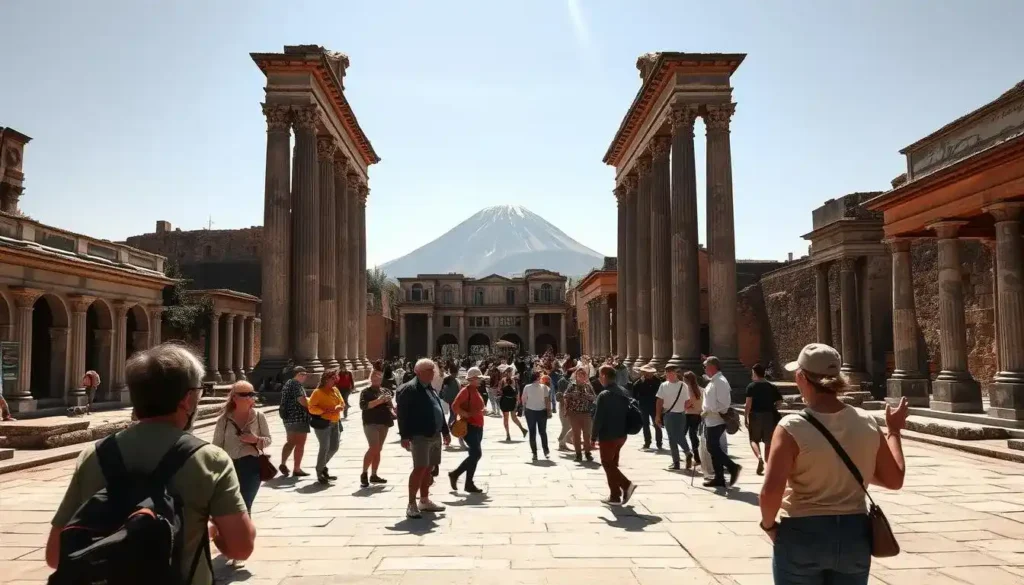
Whether you’re a seasoned traveler or just starting to plan your Italian adventure, our guide will provide you with valuable insights and visiting Pompeii tips to ensure an unforgettable experience.
Key Takeaways
- Learn how to plan your trip to Pompeii
- Discover the top attractions to visit in Pompeii
- Get practical tips on navigating the ruins
- Understand the history and significance of Pompeii
- Make the most of your visit with our expert advice
The Fascinating History of Pompeii
The history of Pompeii is a fascinating tale of daily life, tragedy, and preservation. Pompeii, a Roman city, was a thriving community before its untimely destruction.
Life in Ancient Pompeii
Life in ancient Pompeii was vibrant and diverse. The city’s inhabitants enjoyed a sophisticated way of life, with amenities such as public baths, theaters, and a forum. The presence of thermopolia (ancient fast food restaurants) and bakeries indicates a busy commercial scene. Residents lived in a mix of modest homes and luxurious villas, showcasing the social and economic diversity of the city.
- Public amenities like baths and theaters
- A bustling commercial center with thermopolia and bakeries
- Diverse housing reflecting the city’s social and economic spectrum
The Eruption of Mount Vesuvius and Its Aftermath
The eruption of Mount Vesuvius in 79 AD was a catastrophic event that buried Pompeii under layers of ash, pumice, and rock. This natural disaster resulted in the loss of thousands of lives but also preserved the city, its architecture, and its artifacts for centuries. The aftermath of the eruption left Pompeii frozen in time, providing a unique archaeological site that continues to captivate historians and visitors alike.
- The eruption occurred on August 24, 79 AD
- Layers of ash and pumice buried the city
- The site remained hidden until its rediscovery in the 18th century
Planning Your Visit to Pompeii
To ensure a memorable visit to Pompeii, it’s crucial to plan ahead and be aware of the practical details. This ancient city, frozen in time by the devastating volcanic eruption of Mount Vesuvius, offers a unique glimpse into life in ancient Roman times.
Best Time to Visit Pompeii
The best time to visit Pompeii is during the spring (April-May) and autumn (September-October), when the weather is mild and there are fewer tourists compared to the peak summer months. Visiting during these periods can make your experience more enjoyable and less crowded.
Entrance Fees and Ticket Options
Understanding the Pompeii entrance fees and ticket options is essential for planning your visit. Tickets can be purchased online in advance or at the site. Various ticket types are available, including combined tickets that grant access to nearby archaeological sites like Herculaneum.
Opening Hours and Seasonal Considerations
Pompeii is open year-round, but the opening hours vary depending on the season. It’s advisable to check the official website for the most current information before your visit. Additionally, considering the time of day can help you avoid the crowds and heat, making your visit more enjoyable.
How to Get to Pompeii
Getting to Pompeii is relatively simple, thanks to the well-connected transportation network from major cities.
From Naples
Naples is one of the closest major cities to Pompeii, making it a convenient starting point for your journey. There are multiple ways to travel from Naples to Pompeii.
By Train
The most efficient way to reach Pompeii from Naples is by train. The Circumvesuviana railway line connects Naples to Sorrento, with stops at Pompeii Scavi – Villa dei Misteri. The journey takes approximately 35 minutes.
By Organized Tour
Alternatively, you can join an organized tour that includes transportation from Naples to Pompeii. This option often includes a guided tour of the archaeological site, providing valuable insights into its history.
From Rome
For those traveling from Rome, the most convenient option is to take a train from Roma Termini to Naples, then transfer to the Circumvesuviana line to reach Pompeii. The total journey takes around 2.5 to 3 hours.
From Sorrento and the Amalfi Coast
If you’re visiting from Sorrento or other parts of the Amalfi Coast, you can take the Sorrento-Pompeii bus or drive via the SS18 highway. The journey takes about an hour by car, depending on traffic.
| Starting Point | Mode of Transport | Approximate Time |
| Naples | Train (Circumvesuviana) | 35 minutes |
| Rome | Train (to Naples) + Circumvesuviana | 2.5-3 hours |
| Sorrento | Bus or Car | 1 hour |
The Ultimate Guide to Visiting Pompeii: Must-See Attractions
As you step into the ancient ruins of Pompeii, you’ll discover a plethora of must-see sights that reveal the city’s rich history. Pompeii is home to numerous archaeological treasures, and this section highlights the most significant attractions that visitors shouldn’t miss.
The Forum and Civic Buildings
The Forum was the heart of ancient Pompeii, serving as a central hub for public life, commerce, and governance. The surrounding civic buildings, including temples, basilicas, and municipal offices, provide insight into the city’s administrative and religious practices. Visitors can explore the remains of these structures, gaining a deeper understanding of daily life in Pompeii.
The Amphitheater and Theater District
Pompeii’s Amphitheater is one of the best-preserved ancient amphitheaters in the world, hosting gladiatorial contests, public spectacles, and events. The nearby Theater District, featuring the Grand Theater and the Small Theater (Odeon), showcases the city’s rich cultural heritage. These venues hosted various performances, from theatrical plays to musical concerts.
The House of the Faun and Notable Residences
The House of the Faun is one of Pompeii’s most impressive residences, known for its stunning mosaics and sculptures. This grand house, along with other notable residences like the House of the Vettii, offers a glimpse into the lives of Pompeii’s elite. The intricate designs and artwork found in these homes demonstrate the wealth and sophistication of their former occupants.
The Villa of the Mysteries
The Villa of the Mysteries is a remarkable archaeological site, famous for its vivid frescoes depicting the Dionysian Mysteries. This well-preserved villa provides a unique insight into the religious and cultural practices of Pompeii’s elite. The villa’s stunning artwork and mysterious rituals continue to fascinate visitors.
| Attraction | Description | Significance |
| The Forum | Central hub for public life and governance | Insight into administrative and commercial practices |
| The Amphitheater | Host to gladiatorial contests and public events | Showcases the city’s entertainment culture |
| The House of the Faun | Grand residence with impressive mosaics | Reflects the wealth and lifestyle of Pompeii’s elite |
| The Villa of the Mysteries | Villa with vivid frescoes depicting Dionysian Mysteries | Provides insight into religious and cultural practices |
Lesser-Known Sites Worth Exploring
Pompeii, a city frozen in time, holds many surprises for visitors willing to venture off the beaten path. While the main attractions draw large crowds, there are numerous lesser-known Pompeii sites that offer a glimpse into the daily life and culture of ancient Pompeii.
The Lupanar (Brothel)
One of the most fascinating Pompeii hidden gems is the Lupanar, an ancient brothel that provides insight into the social and sexual practices of the time. With its explicit frescoes and well-preserved architecture, the Lupanar is a unique window into a facet of ancient life that is often overlooked.
The Garden of the Fugitives
The Garden of the Fugitives is another lesser-known site that showcases the tragic fate of those who perished during the eruption of Mount Vesuvius. The garden contains plaster casts of the victims, frozen in their final moments, creating a poignant and haunting experience.
The Bakeries and Thermopolia (Ancient Fast Food)
Exploring the bakeries and thermopolia of Pompeii offers a look into the daily culinary practices of the ancient civilization. These ancient “fast food” establishments and bakeries, with their well-preserved ovens and countertops, reveal the importance of food culture in ancient Pompeii culture.
Visiting these sites not only enriches one’s understanding of Pompeii but also highlights the complexity and richness of life in this ancient Roman city. By exploring these hidden gems, visitors can experience a more nuanced and multifaceted Pompeii.
Practical Tips for an Enjoyable Visit
Visiting Pompeii can be a once-in-a-lifetime experience, and with some practical tips, you can ensure it’s a memorable one. To make the most of your visit, it’s essential to be prepared.
What to Wear and Bring
Comfort and practicality are key when deciding what to wear and bring to Pompeii. The site is expansive, and you’ll likely be doing a lot of walking.
Sun Protection Essentials
Protecting yourself from the sun is crucial, as you’ll be outdoors for most of your visit. Bring sunscreen with a high SPF, a hat, and sunglasses to shield yourself from the sun’s strong rays.
Footwear Recommendations
Wear comfortable, sturdy shoes that are suitable for walking on uneven terrain. The ancient streets of Pompeii can be rough, so avoid sandals or open-toed shoes.
Navigating the Archaeological Site
To navigate Pompeii effectively, consider bringing a map or using a guided tour. The site is vast, and having a clear plan will help you see the most significant attractions.
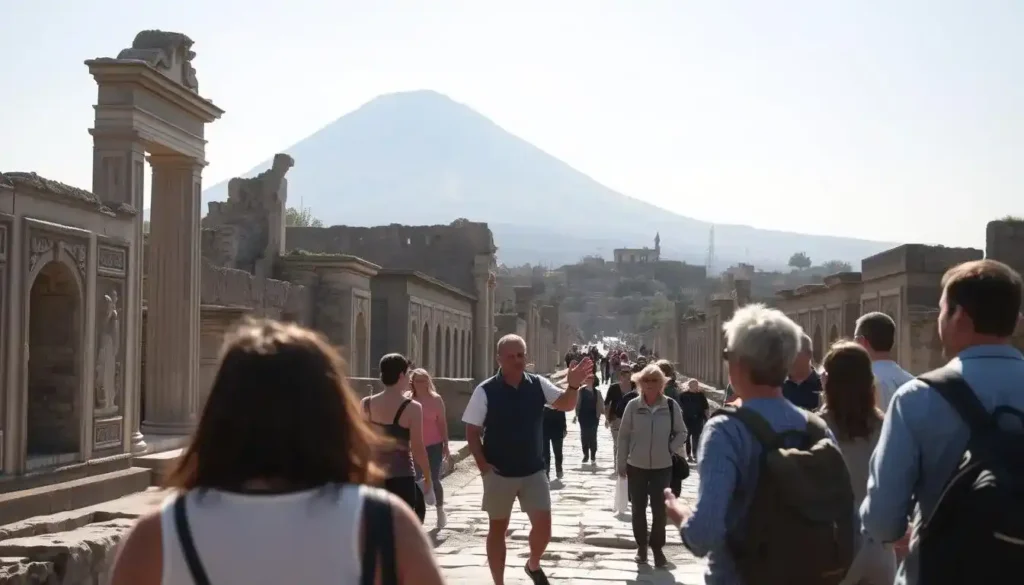
Accessibility Information
Pompeii is committed to being accessible to all visitors. Some areas may be challenging due to the ancient nature of the site, but overall, it’s relatively accessible. Check the official Pompeii website for the latest accessibility information.
| Accessibility Feature | Availability |
| Wheelchair Accessibility | Partial |
| Audio Guides | Available |
| Sign Language Interpretation | Available upon request |
Water and Restroom Facilities
There are water and restroom facilities available on site. It’s a good idea to bring refillable water bottles to stay hydrated throughout your visit.
“The preservation of Pompeii is a testament to the ancient civilization that once thrived there.” –
A Pompeii Guide
Guided Tours vs. Self-Guided Exploration
When visiting Pompeii, one of the first decisions you’ll need to make is whether to embark on a guided tour or explore the ancient ruins on your own. Both options have their merits, and the choice largely depends on your personal preference for structure and information.
Official Tour Options
Official tour options are available for those who prefer a structured experience. These guided tours are led by knowledgeable guides who provide insights into the history and significance of the various sites within Pompeii. They offer a comprehensive overview, helping visitors understand the context and importance of what they’re seeing.
Audio Guides and Mobile Apps
For those who prefer to explore at their own pace, audio guides and mobile apps are an excellent alternative. These tools provide detailed information about the sites, often with the option to listen to additional stories or insights. This option allows for flexibility and can be particularly useful for those who wish to spend more time at certain locations.
Benefits of Hiring a Private Guide
Hiring a private guide offers a tailored experience, allowing visitors to focus on the aspects of Pompeii that interest them most. Private guides can provide in-depth information and answer specific questions, making the experience more engaging and personalized.
In conclusion, whether you choose a guided tour or a self-guided exploration, Pompeii offers a rich and rewarding experience. By considering your preferences and interests, you can select the Pompeii tour options that best suit your needs.
Photography Tips for Capturing Pompeii
The ancient city of Pompeii provides a fascinating subject for photographers, with its well-preserved architecture and poignant history. To capture the essence of Pompeii, photographers must consider several key factors, including lighting, viewpoints, and respectful photography practices.
Best Lighting and Times for Photos
The best time for photography in Pompeii is early morning or late afternoon when the sun is not directly overhead. Soft, golden light enhances the textures and colors of the ancient structures. Avoid harsh midday sun as it can create unflattering shadows and highlights.
Recommended Viewpoints
Some of the most captivating viewpoints in Pompeii include the Forum, which offers a glimpse into the city’s ancient civic life, and the Villa of the Mysteries
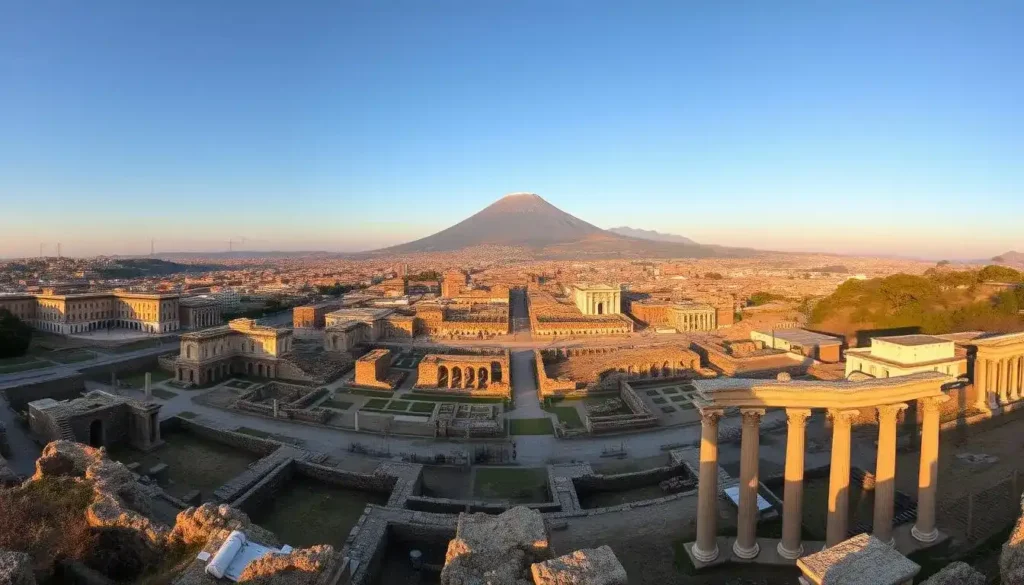
Climbing to higher vantage points, such as the walls or certain ruins, can also provide panoramic views of the archaeological site.
Respectful Photography Practices
When photographing in Pompeii, it’s essential to be respectful of other visitors and the site itself. Avoid using tripods in crowded areas, and be mindful of any photography restrictions in certain areas. As the famous photographer
“Photography is a way of feeling, of touching, of loving. What you have caught on film is captured forever… It remembers little things, long after you have forgotten everything.”
– Aaron Siskind.
By following these photography tips, visitors can capture the beauty and historical significance of Pompeii while respecting the site and its other visitors.
Where to Stay When Visiting Pompeii
Deciding where to stay when visiting Pompeii can significantly impact your travel experience. The right accommodation can enhance your exploration of this ancient city.
Visitors have several options to consider, including staying in modern Pompeii, Naples, or Sorrento. Each location has its advantages and caters to different preferences and travel plans.
Accommodations in Modern Pompeii
Staying in modern Pompeii allows for easy access to the archaeological site. Hotels and B&Bs in the area offer a range of choices for travelers. Some popular options include:
- Hotels near the entrance
- Local B&Bs with traditional Italian hospitality
Staying in Naples
Naples is another viable option, with a wider range of accommodation choices, including luxury hotels. Visitors can enjoy the city’s vibrant culture and cuisine.
Sorrento as a Base
Sorrento is a picturesque town that serves as a great base for exploring Pompeii. It offers a variety of accommodations and stunning views of the Bay of Naples.
Combining Pompeii with Other Nearby Attractions
Visitors to Pompeii can easily combine their trip with other nearby attractions to create a more diverse travel experience. The region is rich in history, culture, and natural beauty, offering a wide range of activities and sights to explore.
Some of the key nearby attractions include ancient ruins, natural wonders, and modern towns, each offering a unique perspective on the area. Here are a few highlights:
Herculaneum
Just like Pompeii, Herculaneum is an ancient Roman city frozen in time by the devastating eruption of Mount Vesuvius. However, Herculaneum was a wealthier town, and its ruins provide a fascinating glimpse into the lives of the Roman elite. Visitors can explore the remarkably preserved houses, public buildings, and even the ancient boat sheds.
Mount Vesuvius
No visit to Pompeii is complete without exploring Mount Vesuvius, the infamous volcano that changed the course of history. Visitors can hike up to the crater, enjoying breathtaking views of the Bay of Naples and the surrounding landscape. It’s a unique opportunity to stand on the rim of an active volcano and appreciate the power of nature.
Naples Archaeological Museum
The Naples Archaeological Museum is home to an extensive collection of artifacts from Pompeii and Herculaneum, including mosaics, sculptures, and everyday objects. It’s an ideal place to gain a deeper understanding of life in ancient Roman times and to see many of the treasures that were recovered from the excavated sites.
The Modern Town of Pompeii
While the ancient city of Pompeii is the main draw, the modern town of Pompeii is also worth visiting. It offers a range of amenities for tourists, including restaurants, shops, and accommodations. Visitors can experience the local culture, try traditional Neapolitan cuisine, and explore the town’s charming streets.
By combining Pompeii with these nearby attractions, travelers can create a rich and varied itinerary that showcases the best of the Campania region. Whether you’re interested in history, nature, or culture, there’s something for everyone in this incredible part of Italy.
Conclusion: Making the Most of Your Pompeii Experience
Visiting Pompeii is a journey through time, offering a unique glimpse into ancient history. By following the Pompeii travel tips outlined in this guide, travelers can enhance their visiting Pompeii experience, exploring the ruins with a deeper understanding and appreciation of this incredible archaeological site.
With its rich history, fascinating ruins, and stunning landscapes, Pompeii is a destination that will leave you with unforgettable memories. Whether you’re a history buff, an archaeology enthusiast, or simply a curious traveler, Pompeii has something to offer everyone, making it a Pompeii experience you will cherish forever.
As you plan your trip, remember to take your time, wear comfortable shoes, and stay hydrated. With these tips in mind, you’ll be able to fully immerse yourself in the Pompeii experience, creating memories that will last a lifetime.
FAQ
What is the best time to visit Pompeii?
The best time to visit Pompeii is during the spring (April-May) and autumn (September-October), when the weather is mild and there are fewer tourists compared to the peak summer months.
How do I get to Pompeii from Naples?
You can get to Pompeii from Naples by train, using the Circumvesuviana railway line, which stops at Pompeii Scavi – Villa dei Misteri station. Alternatively, you can take an organized tour or drive.
What are the must-see attractions in Pompeii?
Some of the top attractions in Pompeii include the Forum, the Amphitheater, the House of the Faun, and the Villa of the Mysteries. These sites offer a glimpse into ancient Pompeii’s culture, daily life, and history.
Can I visit Pompeii on my own, or do I need a guide?
You can visit Pompeii on your own, but hiring a guide or using an audio guide can enhance your experience and provide valuable insights into the history and significance of the site.
What should I wear and bring when visiting Pompeii?
It’s recommended to wear comfortable shoes, bring sun protection (sunscreen, hat, sunglasses), and stay hydrated by bringing water. The site involves a lot of walking, so dress accordingly.
Are there guided tours available from Rome?
Yes, there are guided tours available from Rome to Pompeii. These tours often include transportation and a guide, making it a convenient option for those traveling from Rome.
Can I combine a visit to Pompeii with other nearby attractions?
Yes, Pompeii can be combined with visits to other nearby attractions such as Herculaneum, Mount Vesuvius, and the Naples Archaeological Museum, offering a more comprehensive itinerary.
What are some lesser-known sites to explore in Pompeii?
Some of the lesser-known sites in Pompeii include the Lupanar (Brothel), the Garden of the Fugitives, and the ancient bakeries and thermopolia, which provide a more nuanced understanding of life in ancient Pompeii.
How do I navigate the Pompeii archaeological site?
The Pompeii archaeological site is relatively easy to navigate, with clear signage and maps available. You can also use a guide or audio guide to help navigate the site.
Are there facilities such as restrooms and water available at Pompeii?
Yes, there are restrooms and water facilities available at Pompeii, including near the entrance and at various points throughout the site.

